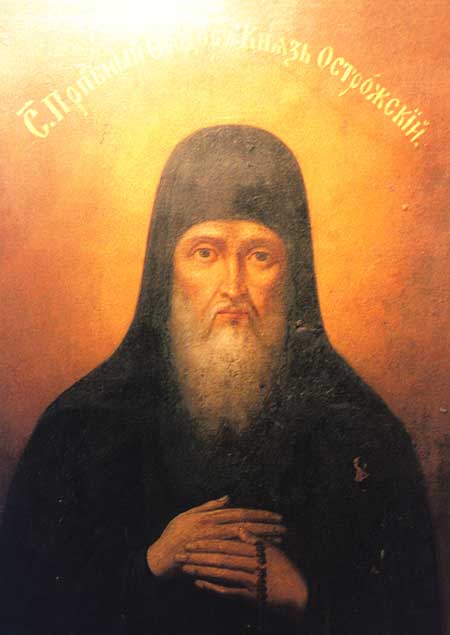Theodore (Theodosius in monasticism) of the Kiev Caves, prince of Ostrog, venerable (1483) (Far Caves)
Dates of commemoration
(Church calendar - Feb 27) Synaxis of all Venerable Fathers of the Kiev Caves (movable feast on the 2nd Sunday of the Great Lent)
(Church calendar - Jun 12) Synaxis of Saints of Belorussia (movable feast on the 3rd Sunday of Pentecost)
Life
Saint Theodore, Prince of Ostrozh, gained fame with the construction of churches and by his defense of Orthodoxy in Volhynia against the enroachment of Papism. He was descended from Saint Vladimir (July 15), through a great-grandson Svyatopolk-Michael, prince of Turov (1080-1093) and later Great Prince of Kiev (+1113).
The first time the name of the holy Prince Theodore is mentioned is in the year 1386, when the Polish king Jagiello and the Lithuanian prince Vitovt affirmed his hereditary possession of the Ostrozh district, and they augmented the Zaslavsk and Koretsk surroundings.
In 1410 Saint Theodore participated in the defeat of the Teutonic Knights of the Catholic Order at the Battle of Gruenwald. In 1422 the holy prince, because of sympathy for the Orthodox in Bohemia, supported the Hussites in their struggle with the German emperor Sigismund. Theodore introduced the Hussite formation (i.e., the Taborite, adopted by the Ukrainian Cossacks) into Russian military strategy.
In 1432, after winning a series of victories over the Polish forces, Saint Theodore compelled Prince Jagiello to guarantee the freedom of Orthodoxy in Volhynia under the law. Prince Svidrigailo, apprehensive of the strengthening of his ally, locked Saint Theodore into prison, but the people who loved the saint rose up in rebellion, and he was freed.
Saint Theodore was reconciled with the offender and went to him for help in the struggle against the Lithuanians and the Poles. In 1438, the holy prince took part in a battle with the Tatars. In 1440, with the accession to the Polish throne of Cazimir, youngest son of Prince Jagiello, Saint Theodore received the rights of administration of the city of Vladimir, Dubno, Ostrog, and he was granted extensive holdings in the best regions of Podolia and Volhynia.
Saint Theodore left all this behind, together with princely power and fame. After 1441 he entered the Kiev Caves monastery, where he received the monastic tonsure with the name Theodosius, he struggled there for the salvation of his soul until the time of his blessed repose.
The year of Saint Theodore’s death is unknown, but it is probable that he died in the second half of the fifteenth century at a great old age (S. M. Soloviev in his HISTORY OF RUSSIA gives the year of his death as 1483). The saint was buried in the Far Caves of Saint Theodosius (He is also commemorated on the Synaxis of the Monastic Fathers of the Far Caves, August 28). His glorification apparently took place at the end of the sixteenth century, since in the year 1638 the hieromonk Athanasius Kal’nophysky testified that “Saint Theodore rests in the Theodosiev Cave, where his body was discovered incorrupt.”
Source:
Holy relic type
unless specified otherwise below, "holy relic" means a fragment of a bone of the saint
Holy relic
Location of the holy relic in the Cathedral:
North kliros, reliquary #5
Troparion
Тропарь преподобного Феодора, князя Острожского, Печерского, в Дальних пещерах
глас 7
Преобразил еси земнаго княжения славу / во иночества образ смиренный, / и вместо врагов видимых / на невидимыя ополчился еси, / и, обою победитель красен являяся, / един от чудотворец Печерских показался еси; / темже и нам ревности Божия дар испроси, / братолюбием сердца наша просвети / и ко спасению вечному стези наша, Феодоре блаженне, направи.
Ин тропарь преподобного Феодора, князя Острожского, Печерского
глас 4
Княжеских дароношений и всего суетствия мирскаго спешне отвергся,/ Божиих же дарований, премудре Феодоре, преискренне сподобитися желая,/ приял еси иноческий образ/ и, в нем смиренным послушанием и безмолвным житием Царю Небесному благоугождая,/ получил еси от Него безсмертныя дары,/ ихже и нам, чтущим тя,/ получити молися.
Ин тропарь преподобного Феодора, князя Острожского, Печерского
глас 4
Яко благочестиваго корене пречестная отрасль был еси,/ блаженне Феодоре,/ яви бо тя Христос/ яко воистинну богодарованное сокровище Волынстей земли,/ новаго поборника веры Православныя,/ и народу российскому преславна и благоприятна./ Темже ныне, плоды светоносных трудов твоих/ в стране нашей под сению Святыя Церкве Православныя наслаждающеся,/ хвалим Господа,/ даровавшаго тебе силу и крепость на сопротивныя,/ Егоже моли спасти отечество твое,/ и державе сродник твоих богоугодней быти,/ и сыновом российским спастися.
Kontakion
Кондак преподобного Феодора, князя Острожского, Печерского
глас 4
Красоты ризныя возгнушавшагося/ и богатства тленнаго со благодарением отвершагося,/ в ризу же безстрастия облекшагося/ и богатому в щедротах Христу возследовавшаго,/ приидите, вернии, восхвалим Феодора достославна,/ яко молящася непрестанно/ о душах наших.






